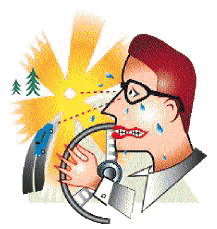 | |
|
Glare research could mean safer roads
Regan, who has studied vision for 35 years, found people with scratches on the lens and cornea of their eyes are highly susceptible to glare. When low-angled sunlight shines into a driver's eyes, such as just after dawn and just before dusk, the light bounces around, forming a hazy image on the retina. Too much haze and your field of vision whites out, sight diminishes and reaction times plummet. Regan explains the effect using a camera lens. "If you rubbed a dirty thumb over it, then light coming from all directions would bounce around inside the lens and go to places it shouldn't be going." During his research, he found that a set of five simple charts he developed years ago to measure low contrast vision in multiple sclerosis patients could be used to test people for glare susceptibility. The "Regan Low Contrast Acuity Charts" are similar to the eye charts optometrists use. Each chart has scrambled letters of various shades of gray -- 100, 50, 25, 10 and four per cent -- on a white background. A person's vision is first tested in a non-glare situation, and then with a glare source. "We measure the ratio between the acuity of the high contrast and the low contrast," he says. "For some people the ratio is one and it doesn't make any difference. But for others it's a ratio of five." For the most part, people don't know they are sensitive to glare, says Regan, who didn't know he was sensitive himself until he was tested. Those who don't know put themselves and others in danger when they drive in high glare situations. Regan would like to see people tested for glare susceptibility when they get their driver's licence. If people knew which category they fell into they could choose to avoid driving when the angle of the sun is low. But, to date, no government has incorporated the glare test into the driving test. "I can't understand why it isn't being used," he says. |
|
Text Menu [ Home | Past Issues | Subscriptions | Contact Us | Site Map | Search Profiles ] |
 Imagine driving home from work late one winter afternoon, and as you round a bend in the road, the low-lying sun shines directly into your eyes. Suddenly you're blinded. The car ahead brakes and .... wham! You smash in from behind. It could easily happen if you're susceptible to glare, according to David Regan, industrial research professor in vision and aviation.
Imagine driving home from work late one winter afternoon, and as you round a bend in the road, the low-lying sun shines directly into your eyes. Suddenly you're blinded. The car ahead brakes and .... wham! You smash in from behind. It could easily happen if you're susceptible to glare, according to David Regan, industrial research professor in vision and aviation.